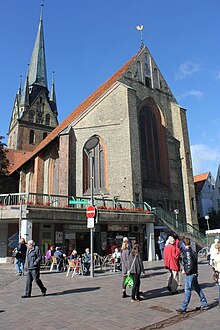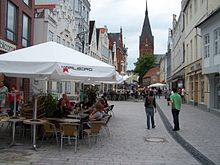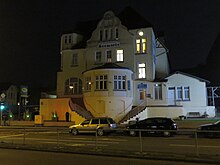Flensburg (Danish: Flensborg) is a city in Schleswig-Holstein located on the east coast. The 90,000 (2018) inhabitants live around the Flensburger Förde (Flensborg fjord). Its main claim to fame besides being a border town is the fact that the central registry for traffic offenses committed throughout Germany is headquartered in Flensburg.

Understand
|
"Flensburg Government" In the last few days of World War 2 most leading Nazis were either in Berlin and going down with their Führer or had tried to escape, sometimes offering to make separate peace with the Western Allies (which Hitler deemed "treason" signing execution orders against anybody who tried it). When Hitler committed suicide, he named various people to various posts in his testament (a thing that was of course against all laws or legal precedent - but the Nazis did not exactly care about such things) but his appointed "successor", Propaganda Minister Goebbels committed suicide after a single day "in office"(as was expected of him) so whatever semblance of a German "government" there still was fell to a bunch of Nazis in and around Flensburg under "President" Karl Dönitz (formerly an admiral) and "Chancellor" Johann Ludwig Graf Schwerin von Krosigk appointed by Dönitz. While the Brits initially let the sham happen under their eyes, because they hoped it could help in ensuring an orderly surrender of German forces (which was signed May 7th by the military leadership) by May 23 the Brits had had enough and arrested the ridiculously top-heavy "government" that had barely "governed" over even Flensburg for less than a month.) |
Get in
By bus or train
- 1 Flensburg station. Sadly the historic main station built in the 1880s which was much closer to most points of interest was shut down and so if you're arriving by train, you'll be somewhat out of town.
There are bus and train connections both from Denmark and Hamburg. Search Bahn.de for public connections in Germany, and DSB for Denmark.
- 2 Zentraler Omnibusbahnhof Flensburg (ZOB) (Central bus station). Built as one of the first central bus stations in Germany in the 1930s and sometimes jokingly referred to as "Gummibahnhof" ("rubber station") it sits at the site of the old central train station and is thus much closer to man points of interest.
By car
Most people arrive here by car. Flensburg is situated at the border of Germany and Denmark, beside the motorway ![]() (
(![]() in Denmark) leading to Hamburg in the south and to Kolding and further north in Denmark.
in Denmark) leading to Hamburg in the south and to Kolding and further north in Denmark.
By plane
The nearest airports are Hamburg (HAM IATA) about 150 km (93 mi) away offering a wide array of flights to domestic and international destinations and Sønderborg (SGD IATA, in Denmark 50 km (31 mi) away; flights from Copenhagen only). Hamburg airport is served by the Hamburg S-Bahn and from Hamburg main station direct RE and Intercity trains leave for Flensburg with a travel time a bit under 2 hours. From Sonderborg airport take a taxi to the rail station and then DSB train.
By boat
- 3 Flensburg harbor. Served by the occasional cruise and able to accommodate private boats. Also includes a "museum harbor" exhibit.
Get around
Walking is the best way to get around in the city centre.
See
Flensburg offers a nice shopping district with old houses and gardens as well as a variety of museums and churches. The harbour is the hosting place for sailing regatta and events.
Museums
"Museum mountain"
- 1 Museumsberg Flensburg, ☏ +49 461 - 85 29 56, fax: +49 461 85 29 93, museumsberg@flensburg.de. Tu-Su: 10:00-17:00. a museum on a hill in the center of Flensburg exhibiting local history artefacts and art by not only local artists. adult 6€, reduced 3€.
- 2 Naturwissenschaftliches Museum (Science Museum) (on the museum hill next to the other museum), ☏ +49 461 - 85 25 04. Tu-Su: 10:00-17:00. adults 6€ reduced 3€.
- 3 Schifffahrtsmuseum (Shipping museum), ☏ +49 461 - 85 29 70, fax: +49 461 - 85 16 65, schifffahrtsmuseum@flensburg.de. Tu-Su: 11:30-17:00. A museum dedicated to Flensburg's maritime history, including a small exhibit on rum, the "Rum-Museum" in the basement. Adult: 6€ reduced: 3€.
There are combined tickets for all the museums on "Museum mountain" (which are rather close to each other) which cost 8€ for adults and 4€ for people who qualify for reduced entry.
Other museums
- 4 Phänomenta. Oct-May: M-F 09:00-17:00, Sa Su 11:00-18:00; Jul-Sep: M-F 10:00-18:00; Sa Su 11:00-18:00. an interactive science museum, where you can try experiments on you own, especially interesting for families and children and anybody interested in science from €9.50 for adults to €7.00 for youth and €2.00 for children.
- 5 Museumswerft (Shipyard museum) (directly on the harbour.), ☏ +49 461 - 18 22 47, werft@museumswerft.de. M-F 08:00-17:00, Sa Su 10:00-17:00; tours are available when booked in advance. this museum shows and builds old ships and boats and offers courses for children, teenagers and adults. 1€ - donations welcome.
- 6 Wehrgeschichtliches Ausbildungszentrum (Kommandeursvilla). Tuesdays from 14:00 to 19:00.. A naval museum in the famous Naval Academy Mürwik. The "Mürwik area" was the last part of Germany left under Nazi German control in May 1945 before the British forces in the area decided to put an end to the charade by having the "government" of "president" (former admiral) Dönitz arrested. free but visitors must show their identity cards.
Churches
The following churches have an interesting architecture and are located in the old centre of Flensburg. Click http://www.flensburg-online.de/kirchen/index.html for an (almost) complete list of churches in Flensburg.
- 7 St. Nikolai (Lutheran).
- 8 St. Marien (Lutheran).
- 9 St. Johannis (Lutheran).
- 10 St. Marien, schmerzhafte Mutter (Roman Catholic).
- 11 Helligåndskirken (Church of the Holy Spirit, Danish church, Lutheran).
Other important churches are the Lutheran Church St. Jürgen which is an typical photo subject. The Church is good to see from the harbour on the eastern shore. A garrison church, with the name Christuschurch, is in the borough Mürwik (Muerwik). The Christuschurch owns a beautiful triumphal cross from the 16th century.
Architecture

- 12 Nikolai-Apotheke (at the "Südermarkt", an old marketplace). One of the oldest buildings in the city. The building was built in the 15th century. The architecture inside as well as outside is very much worth visiting.
- 13 . Built to look like a castle on the orders of German Emperor Wilhelm II and opened in 1910. It was modeled after Marienburg, the Castle of the Teutonic Order, which lays today in the Polish town Malbork. The naval academy has churned out German naval forces under four different political systems (Imperial Germany, Weimar Republic, Nazi Germany and finally the Federal Republic)
- 14 Marinesportsschule (Naval sports academy) (in the borough Mürwik). This part of the Naval Academy was built in 1936/37. In May 1945 it was the seat of the "Flensburg Government" (see infobox).
Do

Tours around the city can be booked at the tourist information center in the old town centre.
- Tourism Agency, Rote Straße 15-17 (the address is Rote Straße, but the door is in the street Klostergang), ☏ +49 461 9090920, fax: +49 461 9090936, info@flensburg-tourismus.de.
A nice way to enjoy the maritime atmosphere of Flensburg is to take a tour on one of the 5 different ferries.
- Alexandra, ☏ +49 461 212-32. The Alexandra was built in 1908 and is so the oldest passenger stream boat which is still in use in whole Germany.
- MS Viking, ☏ +49 174 15 85 555.
- [formerly dead link] MS Möwe, ☏ +49 461 62-945.
- MS Flora II, ☏ +49 177 55 11 114.
- MS Feodora, ☏ +49 172 45 16 791.
Buy

Lots of people arrive in Flensburg from Denmark and the other Nordic countries for shopping. In the old centre of Flensburg are numerous shops along the pedestrian street Holm (Danish: Holmen) and Große Straße and inside the new shopping mall Flensburg Galerie. Certainly a nice place to visit in the centre is the famous "Rote Straße" (Red Street). As part of the traditional "Ochsenweg" the Rote Straße represents a big part of Flensburg's history. Many little shops can be found there. The borough Mürwik (Muerwik) owns also an separate little centre, named Twedter Plack. The centre is on the edge of the military where also located is the Naval Academy Mürwik.
In addition to the numerous small shops in the old centre of the town there's a shopping centre some 2 km south of the city, Förde Park as well as Poetzsch [dead link] at Kupfermühle near the Danish border. Other shopping centres are Scandinavien Park and Citti Park. The Scandinavian Park in the suburb Handewitt is conveniently located right off the northernmost exit of A7 motorway in Germany. Due to its location and tourists visiting it is allowed to open all week long and attracts locals from both sides of the border, who go there for a Sunday grocery run. Price differences between Denmark and Germany may make a certain item a bargain for Danish people but it might be expensive for Germans.
Eat
- Dionysos, Glücksburger Straße 174, ☏ +49 461 140-800. A Greek restaurant in the first floor of Hotel Fruerlund.
- Marien-Café, Norderstrasse 13, ☏ +49 461 500-9711.
- Goldene Lilie, Angelburger Straße 10-16 (opposite of the side entrance of the Fensburg Galerie), ☏ +49 461 26294, fax: +49 461 1505443. 11:30-15:00 and 17:30-23:00. A Chinese restaurant offering a tasty buffet and a good menu.
- Galerie, Holm 66 (located in a garden, opposite the Holm). A restaurant offering a variety of pizza and pasta, non-vegetarian and vegetarian food.
Drink
Sleep

- Hotel am Wasserturm, Blasberg 13, 24943 Flensburg (in Flensburg-Mürwik, there are signs showing the way to the hotel), ☏ +49 461 3150600, info@hotel-am-wasserturm.com.
- Hotel Seewarte, Mürwikerstrasse 164, 24944 Flensburg, ☏ +49 461 35 0 25, fax: +49 461 31 22 87. Check-in: 14:00-21:00, check-out: 07:00-12:00. Inexpensive hotel outside the city centre. Not without reason sometimes compared to British comedy "Fawlty Towers", but the staff is very kind and helpful. No credit cards accepted €35-50.
- Hostel Flensburg, Zur Exe 23, ☏ +49 461 90 90 833, fax: +49 4619090834. Check-in: 16:00-21:00, check-out: till 12:00.
- Jugendherberge Flensburg, Fichtestraße 16, 24943 Flensburg, ☏ +49 461 37 74 2.

Nearby
- Glücksburg Castle (just outside Flensburg). Beautiful old white castle. €5.
- Kiel
- Lübeck
- Hamburg
- Schleswig
| Routes through Flensburg |
| Aalborg ← Åbenrå ← | N |
→ Rendsburg → Hamburg |

